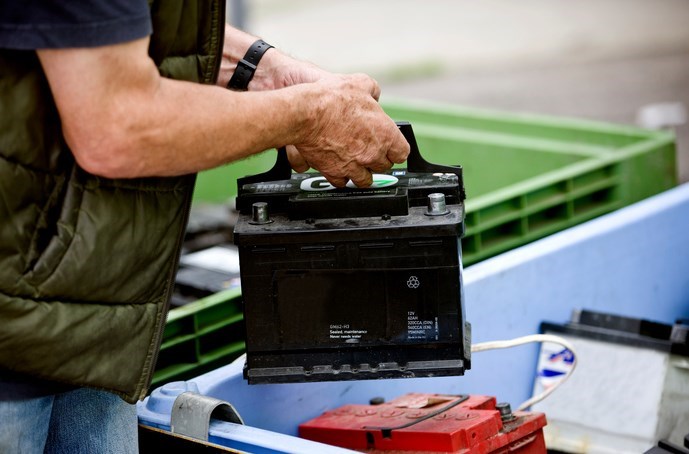Your cart is empty!
Make checkout easy by booking all your reservations at once. Add your sites from different campgrounds into your shopping cart* and then choose checkout.


Reposted from the KOA blog:
The 12-volt-DC electrical system is one of the primary lifelines of an RV. The source of that power can involve some combination of generator, shore power, solar energy, and batteries, as well as the converter and the inverter/charger. Here, our focus is batteries, and the possible choices.
If your RV usually is connected to grid power, you aren’t as dependent on the house battery bank; the primary concerns are proper battery maintenance and avoiding overcharging. However, when you are boondocking, or dry camping, you rely heavily on the batteries’ ability to deliver a steady supply of 12-volt power.
Historically, the go-to battery for RV use has been the flooded lead-acid battery, which is the oldest type of rechargeable battery, invented in 1859. These are the batteries in automobiles, but for RV house use they have larger plates than “starting” batteries, to facilitate deep cycling. While lead-acid batteries haven’t changed much in more than 100 years, newer technologies have introduced other lead-acid batteries to the market, including gel-cells and absorbed glass mat (AGM); both are of a type called valve-regulated lead-acid (VRLA). And recently, lithium-ion (Li-ion or Li+) technology was introduced.
So, which type of battery should you choose for your home on wheels? Also, should you buy 6-volt or 12-volt? Each battery type has its advantages, disadvantages, price range, and requirements. For instance, there are different charging requirements that your existing converter or inverter/charger may not be able to accommodate. So, while you can keep the batteries charged, you run the risk of overcharging or damaging them, or reducing the batteries’ life.
These are still the most common and inexpensive batteries for RV use. Although they can be constructed differently, all batteries of this type consist of lead plates (electrodes) suspended in electrolyte, which is water-based sulphuric acid. Almost all RVs currently in use can accommodate flooded batteries without modification to the charging system. An overview of flooded batteries:
This is the next step in the evolution of batteries. Silica dust is added to the electrolyte of these batteries to create a thick gel. Because the electrolyte is much more viscous, it cannot readily leak or spill. Gel-cell batteries have more stringent charging requirements than AGM batteries. Since the advent of AGM, gel-cell batteries have become rare in RVs.
These batteries go one step further than gel by absorbing the electrolyte into fine fiberglass pads. The pads can be flat, resulting in standard lead-acid battery size and shape, or they can be rolled into cylinders for a smaller battery footprint. Since the electrolyte of AGM batteries is fully absorbed into mats, the batteries are leak-proof and spill-proof, short of major damage to the battery casing. AGM batteries are not subject to the same charging restrictions as gel batteries, so, generally, standard RV charging equipment can be used without modification. Some high-end converters and inverter/chargers have charge settings for AGM batteries, which have charging curves that differ slightly from those of flooded batteries. As with gel batteries, external corrosion is nonexistent with AGM batteries. In addition, gel and AGM batteries are much less prone to sulfation. And internal resistance is much lower in AGM batteries than in flooded cells, so AGM charging time is much shorter.
Although lithium-ion (Li-ion or Li+) battery technology has been around since the 1980s, historically it has been used in smaller consumer devices such as cell phones and laptop computers. With recent advances, the batteries now can work in larger applications such as RVs and standby power plants. They are a marked departure from their lead-acid counterparts.
Comparing the energy density between lithium-ion and lead-acid batteries reveals stark differences. A lead-acid battery can store about 25 watt-hours per kilogram of battery, whereas a lithium-ion battery can store 100 to 265 watt-hours per kilogram. This results in a 50 percent to 70 percent weight savings per amp-hour over a lead-acid battery of the same size.
Lithium-ion batteries also have absolutely no discharge memory, so they are almost 100 percent efficient and can be recharged from completely dead in as little as one hour, depending on the charging technology and battery. This means they can deliver their full rated capacity. The built-in electronics automatically regulate the charging, and chargers designed specifically for lithium-ion batteries are highly recommended. Using a “general” charger could reduce the battery life, but this may not be noticeable by the user.
It is important to understand the administrative functions that a particular battery management system controls, as not all battery circuitry is the same. Lithium-ion batteries require an onboard control circuit; therefore, the cost compared to lead-acid batteries is very high. However, such costs are defrayed when considering battery life, number of charges possible, and the energy output.
The key factor in this choice is current capacity. Two 6-volt batteries must be connected in series in order to achieve 12 volts, whereas two 12-volt batteries must be connected in parallel to maintain 12 volts. In the series configuration, the voltage doubles (6 volts + 6 volts = 12 volts), but the current stays the same. In the parallel scenario, the voltage stays the same, but the current doubles.
One major reason to use 6-volt batteries is to get more current capacity (measured in amp-hours), although that increase may be nominal. The question may arise: If current capacity doubles with two 12-volt batteries configured in parallel, why opt for 6-volt batteries wired in series? The answer: Because of denser plates in a 6-volt battery, the current capacity is more than double that of a single 12-volt battery. Therefore, by installing two 6-volt batteries in place of one 12-volt battery, the mathematical result is a higher current capacity.
The same is true if we double or triple the battery bank. Four 6-volt batteries (wired in a series/parallel configuration) provide more current capacity than two 12-volt batteries, etc. However, installing 6-volt batteries comes at the cost of extra weight and space requirements. Six-volt batteries also may be more expensive than 12-volt batteries. Here is my general advice:
That doesn't mean this area has to always be empty. When you start reviewing camping options, your history will display here to help compare sites and find the best stay. You will be able to share your stay information with friends or family and save it for a later time if you have a KOA Account.
Make checkout easy by booking all your reservations at once. Add your sites from different campgrounds into your shopping cart* and then choose checkout.